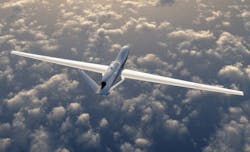Officials of the Naval Air Warfare Center Aircraft Division-Lakehurst in Lakehurst, N.J., are asking radar experts at RDRTec Inc. in Dallas to design a sense-and-avoid radar system for the MQ-8 Fire Scout unmanned helicopter and the MQ-4C Triton unmanned reconnaissance aircraft under terms of a $3 million contract awarded Tuesday.
RDRTec experts will evolve and transition the Radar Autonomous Collisions Avoidance System (RACAS) Sense and Avoid (SAA) radar technology into the Common RACAS (C-RACAS) that fulfills both the Fire Scout and Triton unmanned aerial vehicles (UAVs).
The sense-and-avoid radar that will be common to the two UAVs is to help the unmanned aircraft avoid collisions with other aircraft with the UAVs are not in contact, Navy officials say. The goal of the project is to enhance efficiency in airspace integration.
Related: Air Force surveys industry for companies able to design UAV common sense-and-avoid system
The Fire Scout and Triton UAVs are manufactured by the Northrop Grumman Corp. Aerospace Systems segment in Rancho Bernardo, Calif.
The Fire Scout is an unmanned autonomous helicopter designed to provide reconnaissance, situational awareness, aerial fire support, and precision targeting support for ground, air, and sea forces. The initial RQ-8A version was based on the Schweizer 330, while the enhanced MQ-8B was derived from the Schweizer 333. The larger MQ-8C variant is based on the Bell 407 helicopter.
The Triton is a version of the Northrop Grumman RQ-4C Global Hawk long-range high-altitude reconnaissance UAV adapted for maritime patrol in a support role to the Navy P-8 Poseidon manned maritime patrol jet. The Triton was developed under the Broad Area Maritime Surveillance (BAMS) program.
The Triton will provide real-time intelligence, reconnaissance missions (ISR) over vast ocean and coastal regions,continuous maritime surveillance, as well as search and rescue missions. The UAV will be able to descend through cloud layers to gain close views of ships and other targets at sea when needed. It will track ships and submarines over time by gathering information on their speed, location, and classification.
The contract to RDRTec is part of a Rapid Innovation Fund (RIF) program of the Office of Naval Research (ONR) in Arlington, Va. RIF contracts are ways for programs to help mature candidate technologies. Program managers use these kinds of contracts to move a variety of promising technologies forward, and do not necessarily indicate the specific directions in how a program will advance in the future.
RDRTec specializes in solutions to difficult radar problems involving active electronically scanned arrays (AESA); airborne early warning; anti-submarine warfare; anti-surface warfare; intelligence, surveillance, and reconnaissance; and missile systems, company officials say.
The company has expertise in low, medium and high pulsed-Doppler, synthetic aperture radar, ground moving target indicator, inverse synthetic aperture radar, and detection and tracking of small maritime targets.
In a separate Navy project, RDRTec experts developed radar sense-and-avoid technologies for the Fire Scout UAV using advanced AESA technology and proprietary signal processing to provide actionable collision warning information with lead times longer than 30 seconds involving non-cooperative aircraft moving as fast as 400 knots.
Related: SRCTec to build ground-based radars to enable UAVs to sense and avoid other aircraft
When it comes to AESA radar, RDRTec Inc. is developing adaptive multi-channel phased array manifold radar technology that reconfigures by radar mode for optimum performance.
Company experts are focusing on multi-mode X or C-band radars with phased arrays that support modes with high and low bandwidth requirements. High bandwidth modes include synthetic aperture radar (SAR), inverse synthetic aperture radar (ISAR), and high range resolution (HRR). Relatively low bandwidth modes include ground moving target indicator (GMTI), maritime moving target indicator (MMTI), air-to-air (AA) and sense and avoid (SAA) modes.
RDRTec experts have developed these kinds of technologies and capabilities for the Fire Scout UAV, yet are moving the technologies to other future Navy ISR radars, such as that on the Triton UAV.
For more information contact RDRTec online at www.rdrtec.com, the Naval Air Warfare Center Aircraft Division-Lakehurst at www.navair.navy.mil, Northrop Grumman Aerospace Systems at www.northropgrumman.com, or the Office of Naval Research at www.onr.navy.mil.



